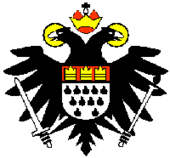- Coat of arms of Cologne
-
The Coat of arms of Cologne (German: Kölner Wappen) refers to more than one Coat of Arms, one for the city and the other for the Electorate and Archbishop of Cologne (German: Kurfürst und Erzbischof von Köln). The arms for the city has existed for some 1000 years and has changed over the course of the history of Cologne. The first known arms are Per fesse dancetté Gules and Argent. A similar arms were used during the Napoleonic era.
Contents
The Arms of the City
The Coat of Arms of the City are Argent, on a chief Gules three crowns Or. Since the second half of the 16th century (between 1550 and 1580) the arms altered to Argent eleven flames (tears) Sable (5/4/2), on a chief Gules three crowns Or. The three crowns symbolize the Magi (Three Wise Men) whose bones are said to be kept in a golden sarcophagus in Cologne Cathedral (see Shrine of the Three Kings at Cologne Cathedral). In 1164, Rainald of Dassel, the Archbishop of Cologne, brought the relics to the city, making it a major pilgrimage destination. This led to the design of the current cathedral as the predecessor was considered too small to accommodate the pilgrims.
The eleven tears are a reminder of Cologne's patron, Saint Ursula, a Britannic princess, and her legendary 11,000 virgin companions who were supposedly martyred by Attila the Hun at Cologne for their Christian faith in 383. The entourage of Ursula and the number of victims was significantly smaller; according to one source, the original legend referred to only eleven companions and the number was later inflated by relic traders.[1]
The Arms of the Arch-bishop
The Coat of Arms of the Archbishop are quarterly argent a cross sable. During the Electorate, the Archbishops were also Princes, and quartered their arms with those of their other titles, such as Duke of Westphalia[2]. Other shields would be combined to represent the Archbishops family and other offices (such as Grandmaster of the Teutonic Knights). Today the Archbishop impales the arms of the office with his own personal arms.
See also
References
- ^ "WM-Stadt Köln: Glaube, Lüge, Hoffnung - Reise - SPIEGEL ONLINE - Nachrichten". Spiegel.de. 2006-06-08. http://www.spiegel.de/reise/metropolen/0,1518,419312,00.html. Retrieved 2009-05-05.
- ^ http://www.heraldica.org/topics/national/armory18/
External links
 Media related to Coats of arms from Cologne at Wikimedia Commons
Media related to Coats of arms from Cologne at Wikimedia Commons- Cologne Coat of arms (English)
- Heraldry of the World: Cologne (English)
Categories:- Heraldry stubs
- Coats of arms of cities
- German coats of arms
- Culture in Cologne
- History of Cologne
- Government of Cologne
Wikimedia Foundation. 2010.


